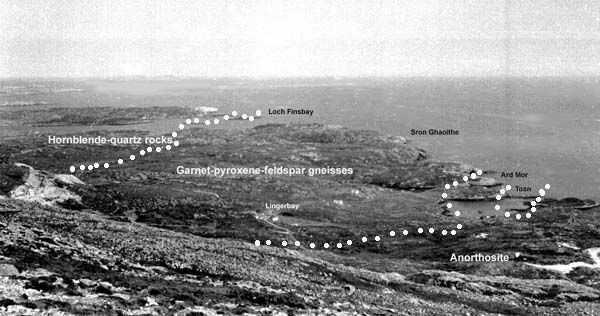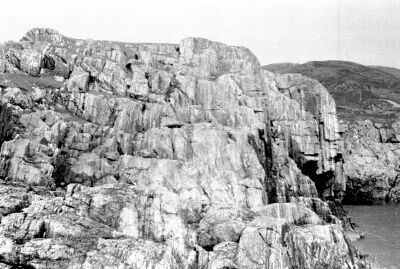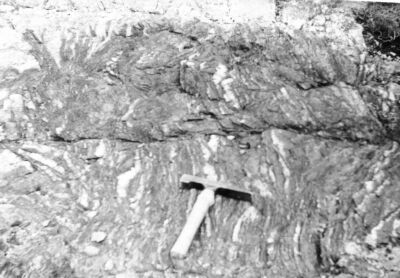
4. IGNEOUS COMPLEX
Overall nature of the unit
The term 'igneous complex' was used by Dearnley (1962, 1963) to describe the meta-igneous rooks of the central part of the area. The dominant rock types are anorthosite and garnet - pyroxene - feldspar gneisses, but other basic rock types, dominantly amphibolites, occur. The anorthosite and garnet - pyroxene - feldspar gneisses are intimately related and the complex was probably originally layered. Therefore the "contacts" of these rook types are necessarily somewhat arbitrary.

Plate 8: The Lingerbay area and its geology from Beinn na h-aire
Lithology:
(a) Anorthosite: when pure, the anorthosites are a brilliant white colour and generally unfoliated in hand specimen. However, there is usually some degree of impurity by red almandine - pyrope garnet, black pyroxene and green hornblende which often constitute bands. The anorthosites consist of up to 96% plagioclase of composition An61-74,(Dearnley 1963, p.264), but this has often been replaced to some extent by fine-grained scapolite. The average grain size is about 1.2mm.
In several localities the anorthosite is rich in garnets, up to 1 cm square, but this rock type was not distinguished from the pure anorthosites during mapping since patches of garnet-anorthosite usually occur in otherwise pure anorthosites, for example on the headland to the west of Eilean Collam and to the south of Uamh. Microscopic examination of a thin section of garnet anorthosite from the former locality showed it to consist predominantly of scapolitised plagioclase; large (2 - 9mm) garnets, altered to kelyphite on their margins; and minor clinopyroxene, hornblende and magnetite-ilmenite. Often the plagioclases show signs of strain, suggesting deformation during growth.
(b) Garnet - pyroxene - feldspar gneisses: The commonest assemblage in this sub-unit is a pyroxene-feldspar one, with or without minor garnet, hornblende, quartz, and scapolite. Quartz and scapolite probably represent metasomatic alteration of the original metamorphic assemblages. Hornblende may have been a primary mineral but at least some is probably due to retrograding of primary pyroxene. Garnet content is extremely variable (between 0% and 30% of the mineral content and such variations often result in colour banding. Such bands may consist of virtually pure anorthosite alternating with garnet-pyroxene bands. Hence hand specimens from a single outcrop may vary between these extremes of composition, and grain sise is also variable. Garnet aggregates may be up to 1 cm square, but are commonly 3 - 4mm square. Colour varies according to proportions of the dominant minerals, from light grey feldspathic rock types to red and black mottled garnet-pyroxene rock types.

Banding in gneisses at the Uisgearich headland, near Rodel
Examination of two thin sections of somewhat altered rock types of this sub-unit shows the following;
(i) Specimen 12 (collected 80 yards north west of the island in the Bayhead inlet). Mineral composition: 51% andesine; 26% epidote; 15% diopside; 8% quartz (with minor magnetite-ilmenite). Grain size is 0.1 - 0.6mm and, in hand specimen, the rock is light green in colour. The epidote is probably a result of post-kinematic alteration, possibly related to movements on the Minch fault.
(ii) Specimen 69 (collected on roadside 300 yards south of the bridge at Bayhead). Mineral composition; 76% scapolitised plagioclase; 17% quartz; 4% diopside; 2% biotite and 1% epidote. The quartz occurs as veinlets, on average 2 mm wide, and grain size is similar to that in specimen 12.
(c) Other rocks associated with the igneous complex:
Most of the other rock types observed in the area of exposure of the anorthosites and garnet - pyroxene - feldspar gneisses (discussed above), are amphibolites. Amphibolites which occur as lenses and schlieren in the above rock types are discussed here. Those which occur as bands cutting the foliation of the above rock types are discussed in section 5.
Such lenses and schlieren are common to the north and west of Loch na Cachlaidh (amphibolites and garnet amphibolites), to the south of Uamh and in Rodelpark (pyroxenites and amphibolites). Generally, these do not exceed 30 yards in length and 20 yards in width, and they are generally much smaller. The rock types are garnet - hornblende - pyroxene - feldspar assemblages, coarse-grained (2mm - 1cm) and very dark coloured. The commonest rock types are amphibolites and garnet amphibolites, usually with little or no feldspar. However there is at least one exposure of a clinopyroxenite,

Plate 2: A lens of garnet - pyroxene - feldspar - hornblende gneiss in anorthosite.
The banding in this lens suggests an intimate relationship between such lenses and the rocks of the igneous complex discussed above and it is probable that these lenses represent layering phenomena on a local scale.
Petrogenesis of the igneous complex
The igneous complex probably resulted from the differentiation of an intrusion of tholeiitic magma. Since there are no clear signs of chilling at the contacts of the intrusion it ia possible that later metamorphism, in the granulite facies, has erased any such feature. This metamorphism resulted in the formation of garnet from olivine, but did not change the igneous assemblages apart from this. Later local metasomatic alteration has resulted in the scapolitisation of plagioclase; the retrograding of pyroxene to hornblende; and in some cases veining with quartz. In extreme cases metasomatic processes (and probably local anatexis) have resulted in rocks which can be described as migmatites. Further local retrograde metamorphism (possibly by dislocation) has resulted in the formation of epidote.
Age of the Complex
The intrusion is almost certainly younger than the Rodel metasediments and the Finsbay hornblendic gneisses and quartzites since it cuts the foliation of the former and the banding of the latter. It is, however, cut by amphibolite dykes, granite pegmatites, and is affected by metasomatism and migmatisation (see above). Dearnley (l963) considers its age to be 'Early Laxfordian* while other workers have suggested it is pre-Scourian, Scourian or Inverian. The intrusion was clearly synkinematic with a phase of deformation, since plagioclase may show signs of strain. Therefore it is possibly Scourian in age. Though its original bulk composition was probably close to the composition of the Scourie dykes of the mainland of Scotland (Wright and Park 1964) there have probably been several phases of basalt and dolerite dyke injection in this region. (Dearnley 1963 p.284) has shown that the bulk composition of the original intrusion was similar to the Tertiary magma types of the Inner Hebrides, though there is clearly no connection between these and the Precambrian igneous complexes of Scotland.)